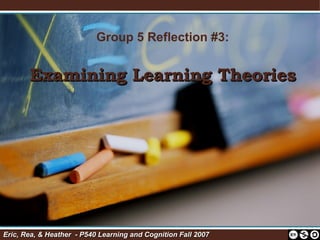Group 5 Reflection 3
•Transferir como PPT, PDF•
7 gostaram•6,026 visualizações
Denunciar
Compartilhar
Denunciar
Compartilhar

Recomendados
Recomendados
Mais conteúdo relacionado
Mais procurados
Mais procurados (20)
Semelhante a Group 5 Reflection 3
Semelhante a Group 5 Reflection 3 (20)
Example ppt lorothy wilson edu622_unit_1_ip_applying_learning_theories

Example ppt lorothy wilson edu622_unit_1_ip_applying_learning_theories
Mais de heasulli
Mais de heasulli (20)
Último
This presentation was provided by William Mattingly of the Smithsonian Institution, during the third segment of the NISO training series "AI & Prompt Design." Session Three: Beginning Conversations, was held on April 18, 2024.Mattingly "AI & Prompt Design: The Basics of Prompt Design"

Mattingly "AI & Prompt Design: The Basics of Prompt Design"National Information Standards Organization (NISO)
Último (20)
Unit-V; Pricing (Pharma Marketing Management).pptx

Unit-V; Pricing (Pharma Marketing Management).pptx
Unit-IV; Professional Sales Representative (PSR).pptx

Unit-IV; Professional Sales Representative (PSR).pptx
Measures of Central Tendency: Mean, Median and Mode

Measures of Central Tendency: Mean, Median and Mode
Mattingly "AI & Prompt Design: The Basics of Prompt Design"

Mattingly "AI & Prompt Design: The Basics of Prompt Design"
Mixin Classes in Odoo 17 How to Extend Models Using Mixin Classes

Mixin Classes in Odoo 17 How to Extend Models Using Mixin Classes
Measures of Dispersion and Variability: Range, QD, AD and SD

Measures of Dispersion and Variability: Range, QD, AD and SD
Russian Escort Service in Delhi 11k Hotel Foreigner Russian Call Girls in Delhi

Russian Escort Service in Delhi 11k Hotel Foreigner Russian Call Girls in Delhi
SECOND SEMESTER TOPIC COVERAGE SY 2023-2024 Trends, Networks, and Critical Th...

SECOND SEMESTER TOPIC COVERAGE SY 2023-2024 Trends, Networks, and Critical Th...
Group 5 Reflection 3
- 1. Group 5 Reflection #3: Examining Learning Theories Eric, Rea, & Heather - P540 Learning and Cognition Fall 2007
- 6. Learning Theory Timeline 900 B.C Socrates – Recollection 1889 Pavlov – Classic Conditioning 1938 Skinner Operant Conditioning 1966 Bruner Discovery Learning 1971 DeBono Lateral Thinking 1972 Craik/Lockhart Thinking Levels 1978 Vygotsky Social Development 1985 Gagne Conditions of Learning 1991 Paivio Dual Coding Theory 1993 Gardner Multiple Intelligence 1903 Thorndike The Law of Effect 1929 Piaget Genetic Epistomology 1913 Watson Behaviorism 1978 Vygotsky Zone of Proximal 1963 Piaget Developmental Psychology 1968 Atkinson/Shiffrin Information Processing
- 8. Recollection
- 15. Learning Curve Graph Knowledge Birth Time
- 17. Behaviorism
- 20. Terminology
- 22. Learning Curve Graph Knowledge Birth Time
- 24. Cognitive Information Processing (CIP)
- 29. Learning Curve Graph Knowledge Birth Time
- 31. Constructivism
- 37. Learning Curve Graph Knowledge Birth Time
- 40. Comparison Learning Theory Socrates’ Recollection Behaviorism CIP Constructivism People Socrates, Plato B.F. Skinner, Thorndike, Pavlov, John B. Watson Lev Vygotsky, Piaget, Dewey Dewey, Goodman, Gibson, Piaget , and many other education and psychology researchers Terms Recollection, truths, soul Radical behaviorism, SRS (discriminative stimulus –operant response, contingent stimulus), law of effect, reinforcements, respondent and operant behavior Sensory, short-term, and long-term memory, encoding, metacognition, storage, retrieval, maintenance rehearsal, imagery, keyword method, mnemonics, schema activation, guided questioning Complex and relevant learning environments, collaboration, autonomy, rote, memory, retention and transfer, SOI model: selection, organization, integration, culture, relativity Mechanism for Acquiring knowledge Knowledge exist before birth, therefore individuals learn by recalling prior knowledge from a previous life, then applying it to current life situations. Knowledge begins with the environment, therefore learning occurs when people react to satisfying and aversive stimuli allowing them to affect our thinking and future decisions. Knowledge is acquired when information is stored in memory (sensory, short-term, or long-term memory), then recalled, and applied into knowledge. Knowledge is acquired or “constructed” when learners actively create their own knowledge by trying to make sense out of new information that is presented to them and build upon previous learnings. Implication for Teachers Teachers must guide students to find answers within themselves. Teachers must apply positive and negative reinforcements to change student behavior and discourage disruptive behaviors. Teachers must create leaning environments conducive to helping and allowing students to apply previous knowledge to current situations. Teachers must provide engaging opportunities for students to make sense of the information via hands-on activities and discussions.